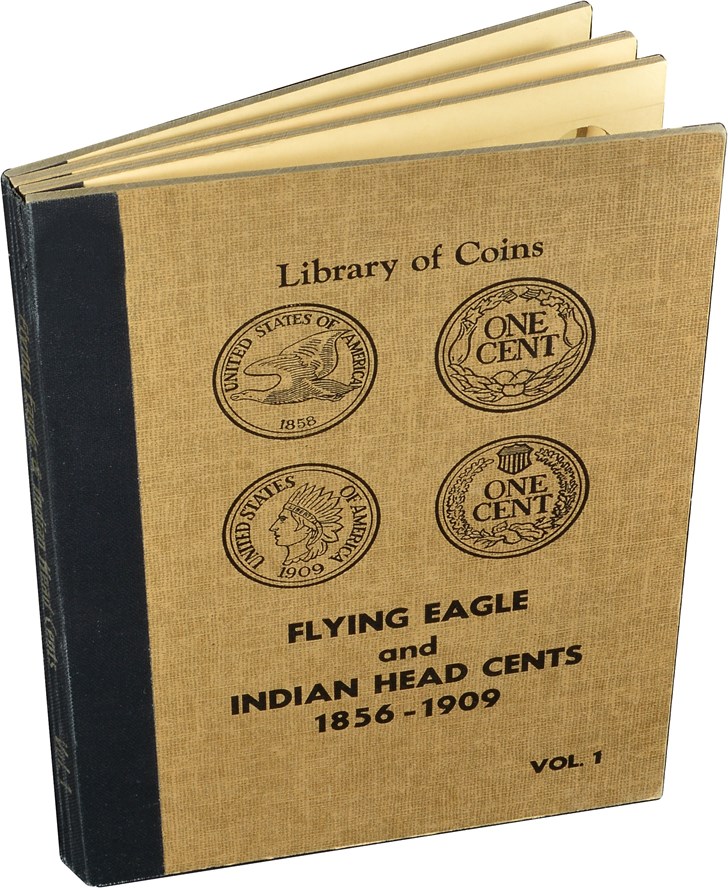USA Coin Album: The Numismatic Legacy of Robert Friedberg - Conclusion
Posted on 3/14/2017
Last month I described how coin dealer Robert Friedberg became the overseer of a large chain of department store coin hobby concessions. These were not owned by the actual stores, but rather by Friedberg and partner Jacques Minkus. Friedberg supplied the collectable coins offered at each store, while Minkus stocked the stamps that were likewise sold at the hobby counter.
One of the things that became evident to Robert Friedberg by the mid 1950s was that existing coin albums and folders left much to be desired. His stores were then stocking the National line of coin albums published by Wayte Raymond, Inc. and distributed by Alan W. Faxon. The folders sold over each counter were of Whitman’s familiar blue line still in production today. Both products appear in pre-1959 issues of the catalog put out by Minkus titled Stamp and Coin News. This publication was given out at the stores to new customers or sent by mail to existing ones. Each issue was identical in content throughout the chain, but it was custom printed with a particular store’s name on the front cover.
The National album had not been improved since the 1930s, yet it remained the industry standard at that time and the album of choice for advanced collectors. Friedberg set about to design a much better album that would eliminate the loose leaf pages and separate binder of the Raymond product. After showing some prototypes to other dealers and making small adjustments based on their comments, he was ready to announce the new line of albums in the spring of 1959. The June issues of both The Numismatist and The Numismatic Scrapbook Magazine featured multi-page ads for the Library of Coins, as Friedberg’s product was named.

Each Library of Coins album was self-bound with heavy, black tape, thus eliminating the need for an expensive ring binder. The covers and pages were made of the same thick cardstock, reducing the variety of parts needed. The title of each album was labeled on its spine in gold, whereas the National album required a separate, paste-on label. When closed, the new albums stood upright and were much more slender than the Raymond binder. Designed to appear as actual books, each album was assigned a volume number within the “Library,” and this number was placed prominently at the lower right of the front cover, as well as being repeated on the spine. The clear plastic slides used in National albums were repeated for the Library of Coins, the sole feature that these albums had in common. Priced at $1.95 for two-page albums, $2.95 for three pages and $3.95 for four pages, the Library of Coins cost less than a comparable National album, in addition to being more convenient. Its success was immediate, and within five years the National Coin Album, as well as its American-brand clone, both went out of production.
The original emission of LOC albums included just 21 titles, these being for the popular series of 20th Century United States coins from cent through dollar. By year’s end, six more titles had been added, and these provided unprinted openings for each denomination. Albums for commemorative coins, proof and mint sets and the Canadian decimal series of coinage joined the line in 1960. Finally, albums for early United States coin series from half cent through trade dollar were added a year later. Unlike the albums of rival publishers that were created during the booming hobby years of 1960-64, the LOC albums for these early series included all of the popular varieties then found in the Red Book (A Guide Book of United States Coins). This has endeared them to generations of coin collectors, and vintage titles offered in the secondary market are still bringing prices higher than those of currently produced coin albums.
All good things must come to an end, and some of the same changes in the coin hobby that drove department store coin counters into extinction also affected sales of the LOC line of albums. In addition, production costs rose so rapidly in the late 1960s that the publisher resorted to an experiment with printing albums in Hong Kong, China. The resulting product was disappointing, and the Library of Coins was discontinued after 1971.
These albums are still fondly remembered and highly sought by veteran collectors, both for the storing of coin sets and as collectibles in their own right. I’m such a collector myself, and I own nearly 200 examples covering all editions and varieties. This passion has driven me to write a series of books detailing the history of coin albums in America and cataloging all known varieties. Volume Two, published by PennyBoard Press, covers the entire line of albums produced by The Coin and Currency Institute, and it also details that company’s various books. Featured, too, is a history of Capitol Coin Company, as well as biographies of Robert Friedberg and his brother Jack, who took over the operation after Robert’s untimely passing. The whole story of the amazing coin concession business built by Jacques Minkus and Robert Friedberg is related through the recollections of those who worked for or shopped at its various stores.
David W. Lange's column, “USA Coin Album,” appears monthly in The Numismatist, the official publication of the American Numismatic Association.
Stay Informed
Want news like this delivered to your inbox once a month? Subscribe to the free NGC eNewsletter today!
